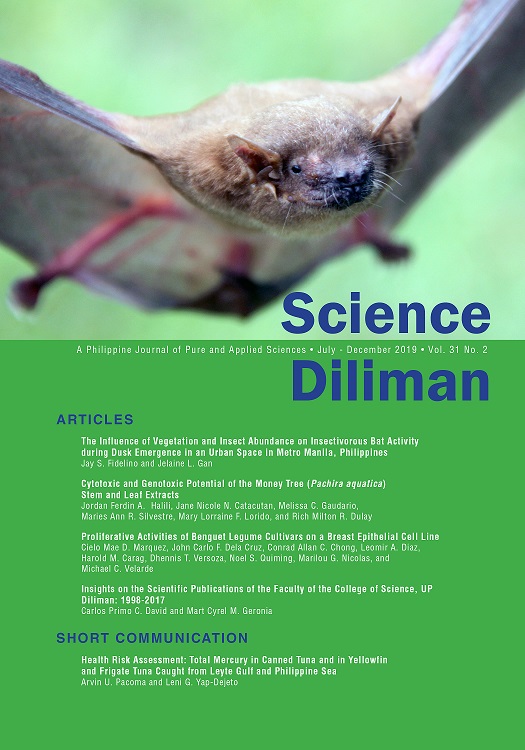The Influence of Vegetation and Insect Abundance on Insectivorous Bat Activity during Dusk Emergence in an Urban Space in Metro Manila, Philippines
Abstract
Because of their importance in the maintenance of ecological processes and sensitivity to multiple stressors, bat activity is increasingly being used to study habitat associations, including the effects of urbanization and other landuse changes. However, to be effectively used as a bioindicator, baseline information on bat activity patterns must first be established. In this study, we aimed to determine patterns of insectivorous bat activity, richness, and assemblage within an urban green space in the Philippines’ capital region in relation to habitat type, insect abundance, and environmental conditions, with particular focus on activity at dusk emergence. Bat activity was measured as the number of bat passes per minute using a portable bat recorder at five time intervals from 5:30 PM to 7:30 PM, and compared between 10 open and 10 forested sites. Bat calls were classified into sonotypes based on five call variables. There was no difference in bat activity between forested and open sites, but more sonotypes were recorded in open sites. Both bat activity and sonotype richness peaked between 6:00 PM and 6:30 PM, representing a short foraging bout upon dusk emergence. However, we did not observe significant relationships between bat activity and insect abundance, air temperature, and relative humidity. Our study found considerable bat activity and diversity in an urban ecosystem, a poorly explored field of research in the Philippines. Additional studies are necessary to understand the impact of landuse changes on Philippine bats, and to inform their conservation and management in anthropogenically altered habitats.
Published
2020-06-22
How to Cite
FIDELINO, Jay S.; GAN, Jelaine L..
The Influence of Vegetation and Insect Abundance on Insectivorous Bat Activity during Dusk Emergence in an Urban Space in Metro Manila, Philippines.
Science Diliman: A Journal of Pure and Applied Sciences, [S.l.], v. 31, n. 2, june 2020.
ISSN 2012-0818.
Available at: <https://journals.upd.edu.ph/index.php/sciencediliman/article/view/7131>. Date accessed: 03 sep. 2025.
Issue
Section
Articles
Keywords
Bioacoustic monitoring, urban ecosystems, insectivorous bats
Submission of a manuscript implies: that the work described has not been published before (except in the form of an abstract or as part of a published lecture, review, or thesis); that it is not under consideration for publication elsewhere; that its publication has been approved by all co-authors, if any, as well as by the responsible authorities at the institute where the work has been carried out; that, if and when the manuscript is accepted for publication, the authors agree to the automatic transfer of the copyright to the publisher; that the manuscript will not be published elsewhere in any language without the consent of the copyright holders; that written permission of the copyright holder is obtained by the authors for material used from other copyrighted sources; and that any costs associated with obtaining this permission are the authors’ responsibility.



